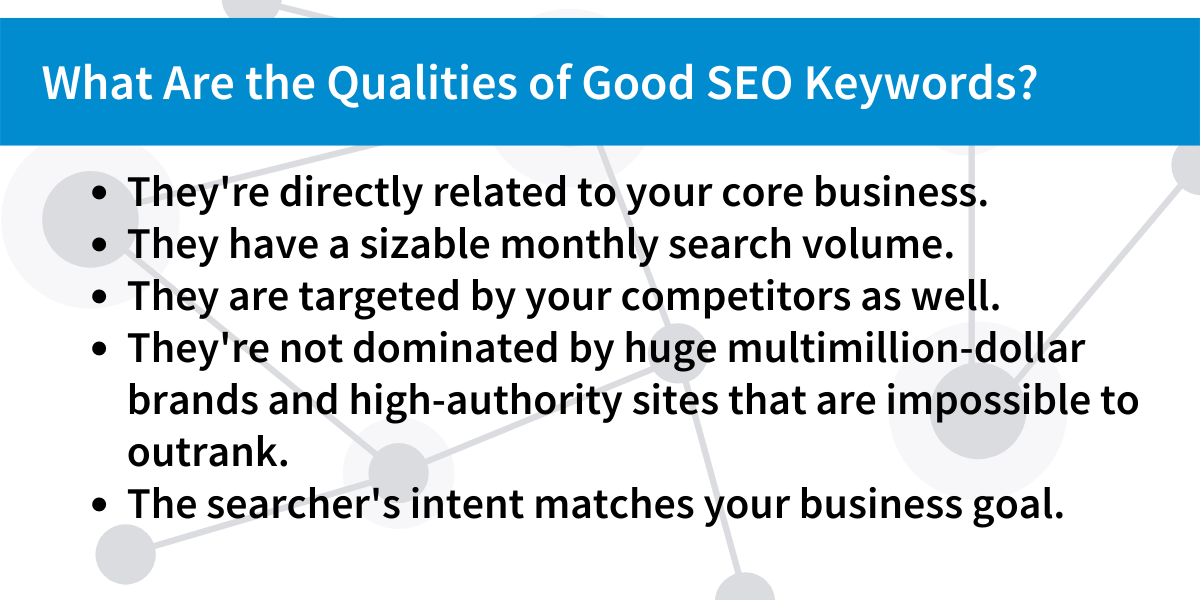How to Write SEO-Friendly Blog Posts: A Step by Step Guide
May 12, 2021 •DJ Team

If you're not properly optimizing your blog content for SEO, you're missing out on thousands of potential website visitors.
Why? Because 93% of all online experiences start with a search engine.
Google, the world's biggest search engine, handles over 3.5 billion searches every day.
By creating SEO-friendly blog posts, you can tap into this unlimited traffic stream and consistently drive relevant visitors to your site without spending money on advertising.
In this article, we'll share step-by-step guidelines on creating SEO-optimized content and show you how to structure a blog post to attract maximum search engine traffic.
Sounds interesting?
Keep reading.
What Is SEO-Optimized Content?
SEO-optimized content ranks for relevant and high-traffic keywords that your audience is searching for on Google and other search engines.
Here are the fundamental qualities of SEO-optimized content:
- Created around your target search keywords so it's easy for Google and other search engines to understand
- Comprehensive and answers your audience's biggest questions better than any of your competitors
- Written and structured to keep readers engaged with your content until the end
- Aligns with the searcher's intent
For example, if your target keyword is "email marketing services," you should create content that answers your audience's most common questions on this topic. It should be more comprehensive and in-depth content than what's currently ranking for your target keyword.
Why is answering your readers' questions so important? Can't you just "stuff" your content with high-traffic keywords to outrank your competitors?
No, because Google has evolved over the years and become much smarter at analyzing content quality, and it uses more than 200 search ranking factors to evaluate content.
But ultimately, all those factors come down to one question: "Is a page giving the users what they're looking for?"
If the answer is yes, Google elevates its rankings. If it's no, then the page keeps wandering on the back pages of Google Search.

The Process for Creating SEO-Friendly Blog Posts
Now that you understand the concept of SEO-friendly content, let's dive deeper into the specifics of how to create such content.
We can break up the process into the following steps.
Step 1: Keyword Research for Blog Posts
To drive traffic from search engines, you need to optimize your content using the right keywords.
Keyword research is the process of finding those keywords. It helps you uncover the search keywords that your audience uses to look for the answers to their questions on search engines.
If you don't get this step right and target irrelevant keywords in your content, you won't drive search traffic, even if your content quality is the best.
So what are the qualities of the right search keywords?
- They're directly related to your core business.
- They have a sizable monthly search volume.
- They are targeted by your competitors as well.
- They're not dominated by huge multimillion-dollar brands and high-authority sites that are impossible to outrank.
- The searcher's intent matches your business goal.
How do you find such keywords?
Keyword research for blog posts starts from competitor analysis and involves consumer research, search trend analysis, the commercial value of keywords, keyword sentiment analysis, and overall competitiveness.
A professional SEO tool like DemandJump can automate your keyword research and find all the insights necessary to choose keywords for your content strategy.
Based on keyword research, you'll be able to identify blog post ideas for beginner, intermediate, and advanced segments of your audience.
The success or failure of your SEO strategy heavily depends on the accuracy of your keyword research. So make sure you do it the right way or seek help from an experienced SEO professional or platform.
Step 2: Understanding Search Intent
Search intent is one of the most important things to consider when choosing a keyword and creating your content.
Even if you choose an ideal keyword and create a high-quality, SEO-optimized blog post about it, Google won't rank you for it if your content doesn't align with the search intent.
What is search intent? It's Google's understanding of what people actually want when they search for a keyword.
For example, when someone searches for an "apple," are they looking for the brand or the fruit?
Similarly, when someone searches for "email marketing," are they looking for the definition of email marketing, the best email marketing tools, or a specific email marketing service?
It helps if you study the search intent of your target keyword before creating content. The easiest way to do that is by searching for your keyword on Google and analyzing the top 10 search results. According to Google, the content format, topic, and structure of the top-ranking pages align with the search intent of your target keyword.
Learn from their approach and use the same content angles.

Step 3: Setting Content Benchmarks
You've found the right keyword and understand the search intent behind it.
It's time to create your content.
But what guidelines should your content follow? What should be the length, structure, keyword usage, or linking strategy?
To answer these questions, set your content benchmarks by analyzing your competitors. Search for your target keyword and open the top 10 results in separate tabs.
Take note of the following things about each result:
- Total word count
- How the keywords are used in the introduction and subheadings
- The number of images used in the content
- The number of external and internal links
- Any data, case studies, or examples used in the content
Now your job is simple.
Create a piece of content that's significantly better than your competitors in each of those factors. For example, if the average content length of the top 10 search results is 1,500 words, make your content at least 3,000 words. Similarly, use more screenshots, data references, and examples than your competitors.
Why? Because doing so will make your content more comprehensive and allow you to cover the topic in more detail than your competitors.
As a result, you'll have a better chance of ranking higher in search results for your target keyword.
Step 4: Creating Your First Draft
Now that you've set your benchmarks, it's time to create pieces people will want to read.
Set aside SEO at this stage and focus on creating comprehensive content that answers your audience's questions better than your competitors. Focus on one or two closely related questions of your audience in every article. Create straightforward content that's easy to read and understand.
Once your draft is ready, move to the next step.
To help you create content faster, here's a content writing template you can use.
Step 5: Optimizing Your Content for SEO
Now that you have the content, it's time to optimize it for SEO.
The first step in SEO optimization is to ensure your content clearly answers your audience's main questions.
Once you create such content, optimize it using your target keyword and its closely related variations. Make sure you're using your keyword and its variations in the following places:
- Early in the title tag, meta description, and URL
- Main H1 heading
- In the first 100 words of your post
- In at least three subheadings using H2 and H3 tags
- In the alt text of the images in your content
- Naturally throughout your body content
- As the anchor text of your internal links
- In the concluding paragraph of your content
Bonus Tip:
- Search for your target keyword on Google and copy the top 10 questions from the "People Also Ask" section in the search results.
- Create an FAQ section at the end of your page, list all the questions you copied in the previous step, and then add one- or two-line answers to each of them.
That's it, you've successfully optimized your content for SEO.
But you're not done yet.
SEO Checklist to Optimize Your Blog Content
Apart from the basic on-page SEO, you need to consider several other factors to fully optimize your blog content.
Here's a helpful SEO checklist for optimizing blog posts.
- Ensure your page is indexable.
- Ensure your page loads within two seconds.
- Ensure your page design is responsive.
- Ensure your content is more comprehensive and detailed than the average content length of your top 10 competitors for your target keyword.
- Use the target keyword in the title, URL, and meta description.
- Use the keyword in the first 100 to 150 words of the page.
- Use your target keyword naturally throughout your content.
- Use natural variations of your keyword throughout your content.
- Use your keyword and its variations in H1, H2, and H3 tags.
- Use the keyword in the conclusion.
- Use the keyword as the alt text of your images.
If you follow all these points, your content will have a great chance to rank higher in search results.
Best Practices for Writing SEO-Friendly Blog Posts
Using keywords and optimizing your content is essential. But it's equally important to structure your content the right way.
Here are a few quick tips for doing so.
1. Use Short Introductions
Try to limit your introductions to 150 words max (including your keyword). Modern-day internet users don't have time for long and vague introductions.
Get to the point, tell your readers what they'll learn in your article, and then move to the main content.
2. Use an Engaging Blog Post Structure
To keep readers engaged with your content through the end, format your content correctly.
Here's how to do it.
- Use a short introduction.
- Break down your article into multiple subheadings.
- Ensure that no subheading has more than 300 words of content under it. If a particular section gets too long, break it down using H3 or H4 tags.
- Use short paragraphs of one to two lines (three lines max) instead of large walls of text.
- Frequently use bullets or lists.
- Use bold, italics, and underlines to highlight the important parts of your content.
- Use at least one image or screenshot in every section of your article.
- Embed a relevant video after the introduction.
This content format helps reduce your site's bounce rate and increases its average session duration. Both these factors strengthen your SEO.
3. Include Link-Worthy Elements
Link-worthy elements help your content get more backlinks from other high-authority sites (crucial for SEO).
Here are the elements you should include in your content.
- Make your content marketing more comprehensive than your competitors.
- Include images, screenshots, and videos.
- Use original research, survey results, or secondary data to back your arguments.
- Frequently use examples in your content.
- Include an infographic in your content.
The more backlinks your content gets, the higher it will rank.
4. Use Internal and External Links Wisely
Internal links help search engines crawl your site deeper and allow you to keep visitors on your site for longer. Similarly, external links make your content more credible in the eyes of your readers and search engines.
Use both internal and external links wherever relevant in your content.
Are You Ready to Create SEO-Friendly Blog Posts?
Creating SEO-optimized content isn't rocket science, as you've seen in this detailed article. But, it still takes time. DemandJump has automated everything but the writing, saving content strategists and writers over 50% of their time! Try it for yourself, and get started creating content that ranks.
Featured Articles
Categories
- Attribution Tracking (13)
- Channel Optimization (11)
- Consumer Insights (68)
- Content Marketing (251)
- Data Science (8)
- Digital Marketing (6)
- Digital Transformation (26)
- Enterprise (10)
- Lead Generation (14)
- Market Intelligence (8)
- Marketing Analytics (39)
- Marketing Attribution (57)
- Marketing Management (153)
- Marketing Operations (86)
- Organic Search (222)
- Paid Search (52)
- Pillar-Based Marketing (63)
- Programmatic Advertising (9)
- SaaS Content (14)
- SaaS Marketing (29)
- Search Marketing (111)
- SEO Keyword Research (28)
- SEO Pillar (18)
- SEO Strategy (46)
- SMB (5)
- Website Content (12)


